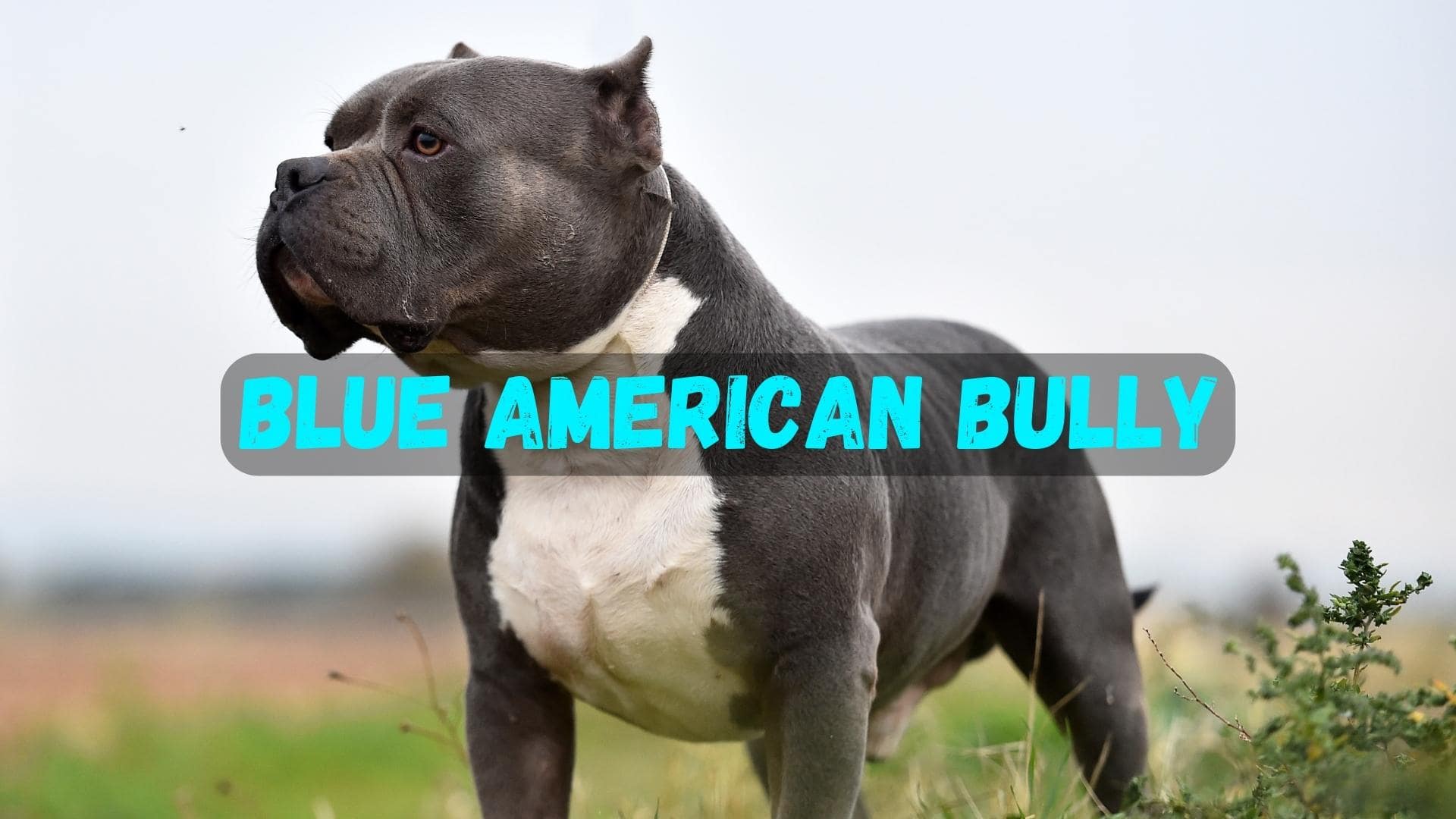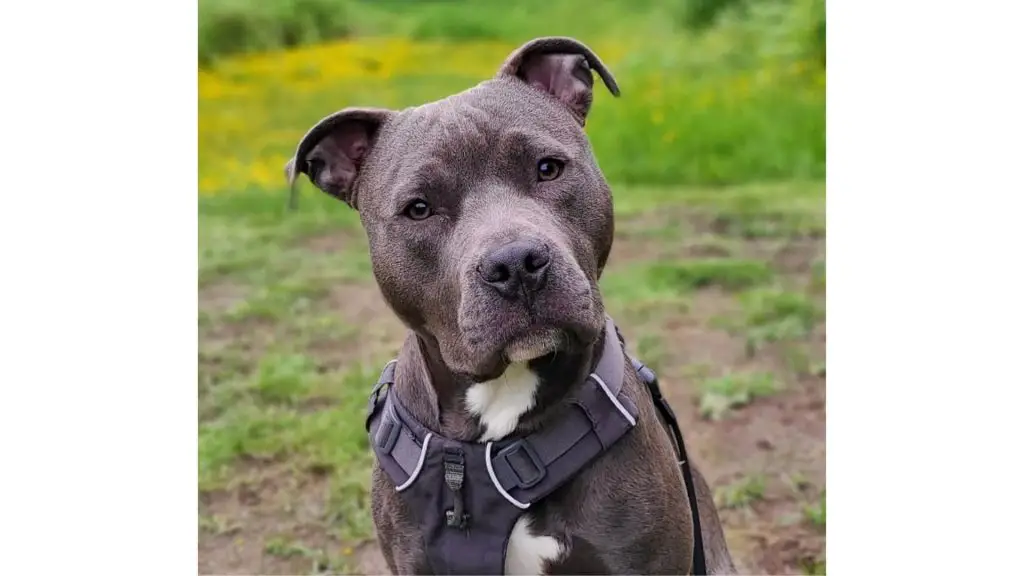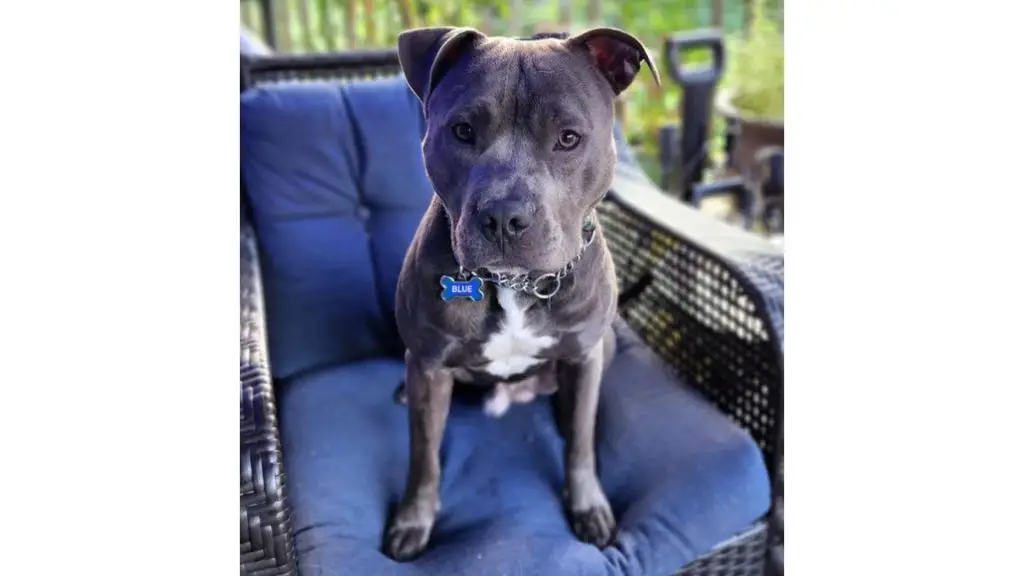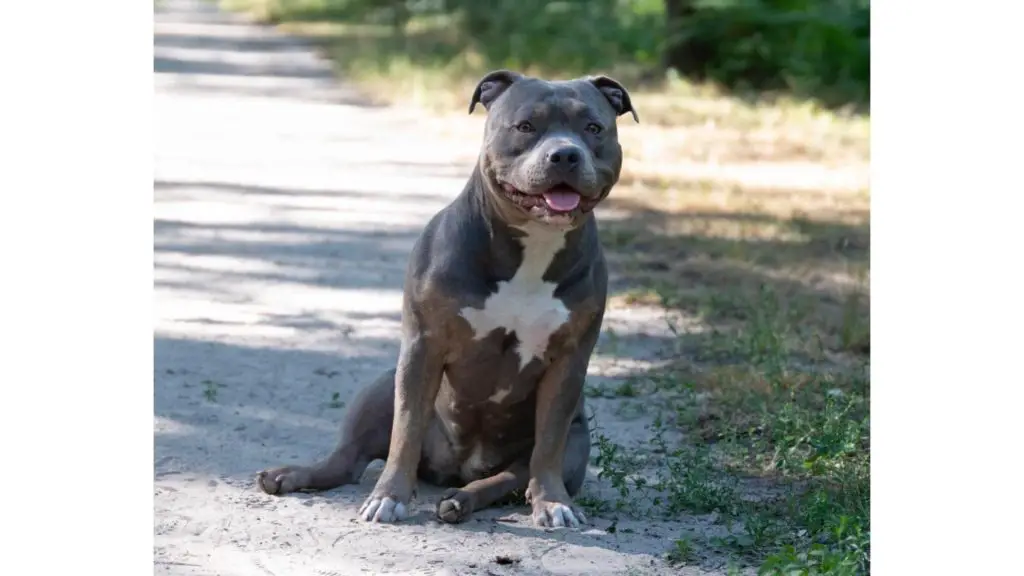Pawscessories is reader-supported. When you buy via links on our site, we may earn an affiliate commission at no cost to you.
Learn more.
If you are looking for a large, muscular dog that is both gentle and protective, the blue American Bully may be the perfect breed for you.
These dogs have become increasingly popular recently, and it is easy to see why! They are loyal and loving companions and make great family pets.
This post will cover all of the basics about these dogs, including their physical characteristics, temperament, care requirements, and much more.
Read on to discover everything you need to know about a blue American Bully.
Table of Contents

What Is a Blue American Bully?
The Blue American Bully is simply a traditional, purebred American Bully with a more unique coat color. They are not a mixed breed. Instead, their blue coloration is caused by a dilution gene they inherit from their parents.
Blue American Bullies can be either solid blue (or grey, as some people call it), merle, brindle, or tri-color.
Outside of their blue coat color, they are really no different than other American Bullies. Their size, temperament, intelligence, and energy levels are the same for the most part.
But, of course, each individual dog is a little different.
Are Blue American Bullies Rare?
While Blue American Bullies are not as common as some other color variations, they are still pretty easy to find if you want to purchase one.
There are a number of breeders who specialize in these dogs, and they are becoming increasingly popular, so the demand is certainly there.
You may have to pay a little bit more for a Blue American Bully than you would for another color, but they are still widely available.
Blue American Bully Female Or Male? Which Is Better?

This is really a matter of personal preference. Each sex has its own unique set of qualities and characteristics that may make it a better fit for your individual situation.
Males are typically larger and more muscular than females and tend to be more protective, territorial, and challenging to train. Typically, this is because it takes them longer to mature.
Females are usually a bit more laid back, easygoing, and usually a little easier to train.
The difference isn’t massive, but people have noticed a slight difference between raising a male or female American Bully.
So when it comes to the question of which is better, it really depends on what you are looking for in a dog.
Blue American Bully Coat Genetics/DNA
Now that we have covered some of the basics let’s take a closer look at the Blue American Bully’s coat.
At its core, the pigment of a dog’s coat is determined by its DNA. There are two main types of pigment that all dogs have, eumelanin and phaeomelanin.
Eumelanin is responsible for black and brown colors, while phaeomelanin is responsible for reds, yellows, and oranges.
The Blue American Bully’s coat color is caused by a dilution gene, which essentially “dilutes” the eumelanin in the coat, resulting in a grey or blue color.
There are a few different genes that can cause this dilution, and the most common one is the D locus.
The D locus has two alleles, D and d. The D allele is the dominant allele, and it results in a normal coat color. The d allele is the recessive allele, and it causes the coat to be diluted.
So, in order for a Blue American Bully to have a blue coat color, they must inherit two copies of the d allele (the dilution gene), one from each parent.
If they only inherit one copy of the d allele, they will have a standard coat color.
Blue American Bully Appearance & Traits

Size (Weight & Height)
The Blue American Bully comes in a few sizes: pocket, standard, and XL.
The pocket size is the smallest of the three, and they typically weigh between 20 and 40 pounds. They are usually about 12 to 16 inches tall at the shoulder.
The standard size is the most common, and they weigh between 40 and 80 pounds. They are usually about 17 to 20 inches tall at the shoulder.
The XL size is the largest, weighing between 60 and 100 pounds. They are usually about 21 to 24 inches tall at the shoulder.
Of course, these are just general guidelines, and some dogs may be a little bit larger or smaller than these averages.
Coat Variations, Markings & Texture
The Blue American Bully’s coat is short and smooth. It can come in several variations: solid, brindle, merle, and tri-color.
Solid Blue American Bully
The solid coat is the most common, and it is a single, even color throughout the entire body. They may have patches of white on their chest, but the rest of their coat is solid blue.
Blue Merle American Bully
The merle coat is a little bit less common and is characterized by a mottled or marbled appearance. The coat’s base color is blue, but it is interspersed with lighter patches of tan, black, and white.
Blue Brindle American Bully
The brindle coat is also a little bit less common and is characterized by light and dark stripes running throughout the coat. The base color of the coat is blue, but the stripes can be any color. However, they are often a tan/brownish color.
Blue Tri Color American Bully
The tri-color coat is the rarest, and it is characterized by three colors throughout the coat. Again, the coat’s base color is blue but has tan and white mixed in.
Generally, the tan/brown points will be on their face and legs/paws, and the white will be on their chest.
Shedding & Grooming
The Blue American Bully is a moderate shedder and will need to be brushed about once or twice a week to help control the shedding.
However, since their coat is short, their fur won’t be as noticeable on your floors and furniture as other breeds with long hair.
In the other areas of grooming, they will need their nails trimmed about once a month, their teeth brushed at least three times a week, and their ears checked and cleaned as needed.
And, of course, a bath every 8-12 weeks or so, depending on how dirty they get.
Are Blue American Bullies Hypoallergenic?
No, Blue American Bullies are not hypoallergenic. They do shed their fur and produce dander, which is what people with allergies are usually allergic to.
Ears & Tail
The Blue American Bully has medium-sized ears that are floppy and set high on their head. Their tails are thick and long, and they usually have a slight curve to them.
However, many Blue American Bullies may have their ears cropped in pictures you see, making them look small and without their natural flop.
Eye Color
The Blue American Bully’s eyes are typically brown but can also be blue, green, or hazel.
Lifespan

The average lifespan of a Blue American Bully is between 10 and 16 years.
This is dependent on a number of factors, including diet, exercise, genetics, and general health.
Common Health Issues
The Blue American Bully is generally a healthy breed, but like all breeds, they are prone to certain health conditions.
Some of the most common health problems seen in Blue American Bullies include hip and elbow dysplasia, allergies, cataracts, and skin problems.
Hip and elbow dysplasia are both hereditary conditions that can cause joint pain and lameness.
Allergies are also a common problem in Blue American Bullies. They can be allergic to anything from food to pollen.
Cataracts are a condition that causes the lenses of the eyes to become cloudy and can eventually lead to blindness.
Blue American Bullies are also prone to skin problems, and they can range from simple dry skin to more serious conditions like mange.
They also have shorter snouts which makes breathing slightly more difficult for them and causes them to overheat more quickly. So while they need plenty of exercise, it’s important to not go overboard, especially in hot weather.
Of course, this is not an exhaustive list, and other health problems can occur. That’s why it is crucial to work with a reputable breeder who health tests their dogs and only breeds from healthy stock.
Trainability & Intelligence
The Blue American Bully is a moderately intelligent breed. They are usually eager to please and reasonably easy to train.
However, they can also be stubborn at times and may need some extra patience when training.
Like all dogs, they will need early socialization and obedience training.
Blue American Bullies do best with positive reinforcement training methods such as treats, praise, and play. Harsh methods such as scolding or hitting are unnecessary and will only make training more difficult.
Activity Level & Exercise Needs

The Blue American Bully is a fairly active breed. They need at least 30-45 minutes of exercise each day, although they will be happy with more if you can provide it.
A good way to provide them with the exercise they need is to take them for a daily walk or jog. If you have a backyard, they will also enjoy playing fetch or other games.
Blue American Bullies also enjoy activities such as swimming, hiking, and agility.
So if you are looking for an active dog to join you on your adventures, the Blue American Bully is a great choice.
It’s also important not to forget about mental stimulation for these dogs. They need to have some sort of activity to keep their minds occupied, or they can become bored and destructive.
Puzzle toys, chew toys, and interactive dog toys are all great ways to keep them mentally stimulated.
Temperament & Behavior
Many people think of the Blue American Bully as an aggressive dog, but this is not necessarily true.
While they can be protective of their family, they are not naturally aggressive dogs.
They can be very friendly and good with children and other animals with proper socialization and training.
They are also usually very patient and good-natured dogs.
However, like all dogs, they can have their own unique personalities. So it’s important to get to know them before you bring one home.
In general, they are not overly vocal dogs and can make a great addition to any family. As long as they receive adequate socialization and training, a blue American Bully can be a great pet.
Blue American Bully Puppy Price

A Blue American Bully puppy generally costs anywhere between $2,000 to $10,000.
This price range will depend on factors such as the breeder, the dog’s parents, and whether or not the dog comes with any additional certification.
For example, a dog with championship bloodlines is going to be more expensive than a dog without any special lineage.
Also, solid blue and blue brindle American Bullies are generally the cheaper blue coat types costing anywhere between $2,000 to $7,000. Whereas the blue merle and blue tri-color American Bullies can be upwards of $10,000 but are likely to be between $7,500 and $10,000.
As with all dogs, always make sure you are dealing with a reputable breeder.
There are unethical breeders out there looking to make a quick buck by selling sick or unhealthy puppies. Especially when it comes to rare coated dogs.
Where Can You Find a Blue American Bully For Sale?
There are a few different places you can look for a Blue American Bully for sale.
The first place to start is with a reputable breeder.
A good breeder will be able to answer all of your questions and help you find the right dog for your family.
A few independent breeders that have been breeding American Bullies for many years are:
- Buff N Blue Bullies (buffnbluebullies.com)
- MONSTER BULLIES (monsterbullies.com)
- Top Dog Bullies (topdogbullies.com)
You can also check out breeder directory websites if you cannot find a blue American Bully breed in your area. These websites allow breeders from all over the country to list their puppies for potential owners to look at.
AKC’s Marketplace and Greenfield Puppies are well-known breeder directories that you can also check out.
Remember, always ask the breeders questions to ensure they are continuing to breed in a reputable manner.
Other FAQs
Does the Blue American Bully Drool a Lot?
The Blue American Bully is not a particularly drooly breed. They may drool more when eating or drinking, but it is not excessive.
Do Blue American Bullies Have Blue Eyes?
Some Blue American Bullies may have blue eyes, but it is not common. It’s more common for them to have brown eyes.
Are Blue American Bullies Pitbulls?
The Blue American Bully is not a Pitbull. They are a separate breed. However, they do share some similar ancestry.
This is a common misunderstanding. Mainly because the term “Pitbull” is often used to describe any dog with similar physical characteristics to Pitbulls, even if they are not actually Pitbulls.
So while the Blue American Bully is not a Pitbull, they do share some similarities with them.
This includes their muscular build, short coat, and wide head.
Final Thoughts
The Blue American Bully is a beautiful dog that can make a great addition to any family.
They are typically very friendly, good-natured dogs that can do well with children and other pets. As long as they receive adequate socialization and training, a blue American Bully can be a great pet.
Just make sure you are getting your dog from a reputable breeder and that you are prepared to handle a strong and active dog.
Other posts you might find interesting:
